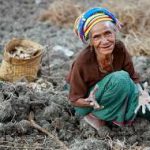 By Nageshwar Patnaik in Bhubaneswar, September 8, 2024: ‘The law will take its own course’ is a favourite adage of our netas. Does the law take its own course? Most of the time, it does not. The classic case is the crime against women. Rape is one of the most terrible crimes on earth and it happens every few minutes.
By Nageshwar Patnaik in Bhubaneswar, September 8, 2024: ‘The law will take its own course’ is a favourite adage of our netas. Does the law take its own course? Most of the time, it does not. The classic case is the crime against women. Rape is one of the most terrible crimes on earth and it happens every few minutes.
The rape cases are rising alarmingly while conviction rates remain very low. There were more than 31,000 reported rapes in 2022, the latest year for which data is available. India is one of the countries with the lowest per capita rates of rape, because an estimated 99.1% of sexual violence cases go unreported.
According to the National Crime Records Bureau (NCRB), there was a 20 percent increase in reported rapes in 2022 compared to 2021. In 2012, police were recording up to 25,000 rape cases a year across the country and since then, the annual number has largely remained above 30,000, except a sharp fall in 2020 when the COVID-19 pandemic broke out. Attacks on women peaked at nearly 39,000 in 2016. According to the NCRB, in average one rape takes place in every 6 minutes. It implies, approximately 100 rapes in a single day..
Conviction rates for rape ranged between 27%-28% from 2018-2022. It is crystal clear that there is high crime rate then the conviction rate. As on average, the conviction rate is under 30% means rest 70% of accused are walking freely outside and repeating same activities.
In Britain, by comparison, the conviction rate for cases linked to rape was 60.2% in FY2023-24 and 63.5% the year earlier, according to Crown Prosecution Service data. In Canada, 42% of all sexual assault case decisions in adult criminal courts resulted in a finding of guilt in 2016-17, the Department of Justice said. That figure had been stable over the preceding 10 years.
 Attacks on women continue to occur in public places across India, despite stringent laws. Early this week on September 4, a man in Madhya Pradesh’s Ujjain forced a woman – who collects scrap, to drink alcohol and then sexually assaulted her in public while the act was shamelessly video recorded by passersby.
Attacks on women continue to occur in public places across India, despite stringent laws. Early this week on September 4, a man in Madhya Pradesh’s Ujjain forced a woman – who collects scrap, to drink alcohol and then sexually assaulted her in public while the act was shamelessly video recorded by passersby.
Last month, a 31-year-old woman medical resident was raped and murdered inside her workplace, RG Kar Medical College and Hospital, in Kolkata. The case, which is currently under investigation by the Central Bureau of Investigation, has touched off protests across India as the country struggles with growing number of rape cases exposing inadequate protections for women.
There were significant enhancements to punishments in the wake of the 2012 Delhi gang rape (commonly known as the Nirbhaya case), and the incidents of child rape and murder in Kathua. The Kathua rape case involved the abduction, gang rape, and murder of an 8-year-old Muslim girl, Asifa Bano, by seven males (six men and a juvenile) in January 2018 in the Rasana village near Kathua in Jammu and Kashmir, India.
Faced with mounting public and political pressure, governments take the easiest route to make tough laws to apparently demonstrate their commitment to addressing sexual violence. Amid the growing outrage over the Kolkata rape case, the West Bengal government has significantly enhanced punishments for sexual offences against women and children in the Aparajita Woman and Child (West Bengal Criminal Laws Amendment) Bill, 2024 passed by the state assembly. Among the proposed enhancements is the mandatory death penalty for rape that results in death or permanent vegetative state of the victim. Incidentally, mandatory death penalty has been declared unconstitutional by the Supreme Court in Mithu v State of Punjab (1983).
However, the moot question is will harsher punishments lead to a sharp fall in violence on women in our society? Sexual violence is an outcome of deeply ingrained gender, caste, and religious hierarchies that routinely produce and legitimize sexual violence. One of the main reasons behind raising rape is due to the male-dominated society. Women have a low representation in such societies and many men think that women are only born to be used. Other reasons of rising rape cases are due to the ignoring the relationship between poverty and violence, the stigma and blame attached to rape, lack of proper gender education, and also the difficult path to justice. Ironically, the perpetrators are well-known to the victims in over 90 per cent of rape cases.
Rape is an assertion of power. Two things are important to be considered when in the context of rapists: extent of punishment and likelihood of getting caught. Unfortunately, our society gives more importance to only the first one. According to NCRB reports, rape cases pending trial stood at more than 133,000 by the end of 2016. One Case can be Fast-tracked and the accused can be given the death penalty but what about 132,999 cases pending, that is why more focus should be given to conviction rather than punishment.
 Deep-rooted inequalities perpetuated by the caste system add to the complexity of the problem, with women from poor and lower caste backgrounds being at greater risk of rape and sexual assault. In fact, there was a 45 per cent increase in reports of rapes of Dalit women between 2015 and 2020, and women from Scheduled Tribes (STs), Scheduled Castes (SCs), and Other Backward Classes (OBCs) remain disproportionately affected by sexual violence in comparison to women who are not marginalized by caste or tribe.
Deep-rooted inequalities perpetuated by the caste system add to the complexity of the problem, with women from poor and lower caste backgrounds being at greater risk of rape and sexual assault. In fact, there was a 45 per cent increase in reports of rapes of Dalit women between 2015 and 2020, and women from Scheduled Tribes (STs), Scheduled Castes (SCs), and Other Backward Classes (OBCs) remain disproportionately affected by sexual violence in comparison to women who are not marginalized by caste or tribe.
Harsher punishments will barely deter offenders as the conviction rates in rape cases are below 30 per cent. It is the certainty of the punishment and not its severity that deters crime. Effective and prompt investigations, broader social reforms, sustained governance efforts, and stronger criminal justice institutions will be the key to pursuing accountability for sexual violence.


Leave a Reply
Be the First to Comment!